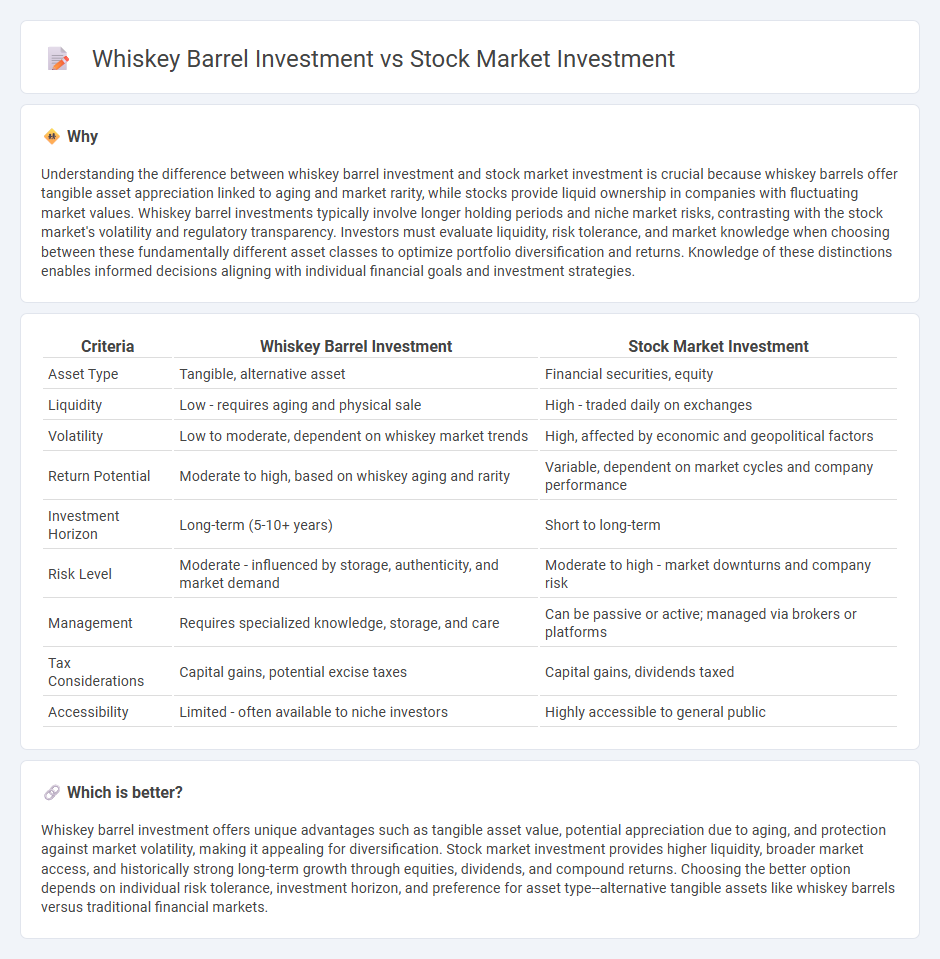
Whiskey barrel investment offers a tangible asset with potential appreciation driven by aging and rarity, contrasting with stock market investment's liquidity and market-driven price volatility. Whiskey barrels can provide portfolio diversification and may hedge against inflation, while stocks typically offer dividends and capital gains tied to corporate performance. Explore how each investment aligns with your financial goals and risk tolerance in detail.
Why it is important
Understanding the difference between whiskey barrel investment and stock market investment is crucial because whiskey barrels offer tangible asset appreciation linked to aging and market rarity, while stocks provide liquid ownership in companies with fluctuating market values. Whiskey barrel investments typically involve longer holding periods and niche market risks, contrasting with the stock market's volatility and regulatory transparency. Investors must evaluate liquidity, risk tolerance, and market knowledge when choosing between these fundamentally different asset classes to optimize portfolio diversification and returns. Knowledge of these distinctions enables informed decisions aligning with individual financial goals and investment strategies.
Comparison Table
| Criteria | Whiskey Barrel Investment | Stock Market Investment |
|---|---|---|
| Asset Type | Tangible, alternative asset | Financial securities, equity |
| Liquidity | Low - requires aging and physical sale | High - traded daily on exchanges |
| Volatility | Low to moderate, dependent on whiskey market trends | High, affected by economic and geopolitical factors |
| Return Potential | Moderate to high, based on whiskey aging and rarity | Variable, dependent on market cycles and company performance |
| Investment Horizon | Long-term (5-10+ years) | Short to long-term |
| Risk Level | Moderate - influenced by storage, authenticity, and market demand | Moderate to high - market downturns and company risk |
| Management | Requires specialized knowledge, storage, and care | Can be passive or active; managed via brokers or platforms |
| Tax Considerations | Capital gains, potential excise taxes | Capital gains, dividends taxed |
| Accessibility | Limited - often available to niche investors | Highly accessible to general public |
Which is better?
Whiskey barrel investment offers unique advantages such as tangible asset value, potential appreciation due to aging, and protection against market volatility, making it appealing for diversification. Stock market investment provides higher liquidity, broader market access, and historically strong long-term growth through equities, dividends, and compound returns. Choosing the better option depends on individual risk tolerance, investment horizon, and preference for asset type--alternative tangible assets like whiskey barrels versus traditional financial markets.
Connection
Whiskey barrel investment and stock market investment both serve as alternative asset classes that provide portfolio diversification and potential for long-term appreciation. Whiskey barrels offer tangible assets with value linked to the aging process and rarity, while stock market investments rely on company performance and economic factors. Investors often balance these options to mitigate risk and enhance overall returns through a blend of physical commodities and financial securities.
Key Terms
**Stock Market Investment:**
Stock market investment offers liquidity, diversification, and potential for steady long-term growth through equities, bonds, and mutual funds, making it a flexible and accessible option for many investors. Unlike whiskey barrel investment, which involves physical asset storage and longer maturation periods, stock market assets can be quickly bought or sold, adapting to market conditions and investor needs. Explore comprehensive insights to understand how stock market strategies can optimize your financial portfolio.
Dividend Yield
Stock market investments often provide stable dividend yields, with averages around 2-4%, offering regular income streams from established companies. Whiskey barrel investments, while less liquid, can deliver unique returns through barrel appreciation and eventual resale, though dividend-like yields are rare or absent. Explore the detailed yield comparisons and risk profiles to determine which investment aligns with your financial goals.
Price-to-Earnings Ratio (P/E Ratio)
The Price-to-Earnings (P/E) ratio is a key metric in stock market investment, reflecting a company's current share price relative to its earnings per share, and helps investors assess stock valuation and growth potential. Whiskey barrel investment, lacking standardized earnings data and public trading prices, requires alternative valuation methods such as aging, provenance, and market demand analysis, making direct P/E comparison challenging. Explore further to understand the nuances and investment strategies behind financial metrics and alternative asset classes.
Source and External Links
How to Invest in Stocks: 2025 Beginner's Guide - To invest in stocks, open an online brokerage account, add money, and purchase stocks or stock-based funds, with low-cost index funds and ETFs recommended for long-term growth and risk management.
Stocks - Stocks give partial ownership in a company and offer potential growth over long periods, but they carry risks including price volatility and potential loss, especially if a company goes bankrupt.
The Basics of Investing In Stocks - Stocks can provide capital gains and dividends but involve risks like price declines and company failure; stocks can be bought via direct stock plans, dividend reinvestment plans, or brokers.
 dowidth.com
dowidth.com